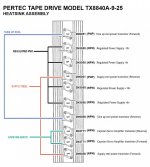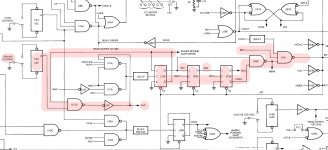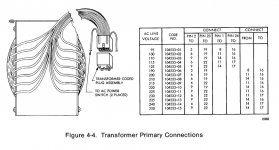Here is the next episode of my troubleshooting adventure
1. Fuse blown and discovery of dead Q48 (2N6051 PNP)
2. Q48 replaced by an equivalent (BDX66C)
3. The Load process starts normally (extension of the tension arms) but the Supply Reel only turns forward, tension arm inoperative, no polarity inversion of the Supply Reel, the tape drive of course does not manage to put the magnetic tape in tension.
4. The Take up reel turns in the good direction (clockwise), tension arm operating correctly, depending on its position, the motor speed changes until the motor polarity is reversed.
5. Discovery of a dead light bulb in the optical sensor of the tension arm of the Supply reel (Yes ! That's it!)
6. Replacement by a led, same result (maybe my led does not give off enough light?)
7. Tests of the sensor with the led on the Take Up reel, my sensor is working (so this was not the reason for the failure)
8. I decide to interchange Q43 and Q49 (2N6058 NPN) so as to make operational the supply reel instead of the take up reel and thus have the confirmation that the problem is at the level of Q49 (Q48 & Q49 are matched pair of PNP NPN transistor supplying the reverse polarity for the supply reel motor).
9. The fuse blown again! I do not understand why !
10. I decide to note the color of the wires on my HEATSINK ASSEMBLY picture and unsolder all the transistors.

11. I discovered that my new Q48 (BDX66C) was killed by this interchange of 2N6058 (therefore between Q43 and Q49).
12. With the multi-meter I measure that all the other transistors are good (but finally a multi-meter is it enough to test the good health of the power transistors?
13. I resolder everything with a new Q48 (a BDX66C as equivalent for the 2N6051), As these 2N6051 seem fragile, I also replace Q42 with a BDX66C I put new insulators on some transistors because their mikas seem a little crackled (can be the cause of a short circuit).
14. I replace the fuse.
15. During the test the Load procedure also starts, this time it is the Supply reel which functions normally but the Take up reel which unwinds the tape (clockwise) instead of winding it (counter clockwise) and it is also this times the tension arm on the side of the Take up reel which no longer responds. In fact it's the exact opposite situation of point 3. and 4. described above.
16. By testing the motor polarity reversal by manually retracting the tension arm of the Supply reel, it suddenly stops functioning, the motor continues to vary speed but does not go in the other sens of rotation.
17. I order two BDX67C equivalents to replace the two 2N6058 in Q43 and Q49 and in the process, I order two more new BDX66Cs (I am starting to doubt my ability to know when they are functional or not. I have high hopes, BDX66C and BDX67C are "matched pairs".
18. I resolder the 4 new components, I test with a piece of magnetic tape in front of the optical detector to start the LOAD sequence, the tension arms are deployed, and by pressing the LOAD button, the two motors start to run, I 'manually actuate the tension arm, reversing the motors polarity, YES ! it works !!
19. Full of hope, I tested with a magtape this time: He almost succeeded in putting it under tension, but the arm tension touched the limit switch, I said to myself: "no big deal, the positioning values of the arms must be readjusted ", before that I still try to tension the tape, but oddly enough, instead of having the same result, it works less and less well.
20. Even before having been able to check the adjustments of the tension arms, it stop working at all, the reels turn only in one direction:
- The Supply reel clockwise
- The Take up weel counter clockwise
If I activate the tension arm, I can vary the speed and even stop the motors, but neither start in the other sens of rotation.
At this stage I am wondering if I have not again gunned my new BDX66C or BDX67C equivalents because since the replacement I have these motor movements described above which works perfectly now, with the speed gradation, I just lost the opposite movement on these two motors, I wonder if these BDX66C & BDX67C are beefy enough. With what type of more powerful transistors could I replace these fragile BDX66C and BDX67C?
I also wonder if the cause of this failure would not be elsewhere now, by dying, the first Q48 impacted the transistors of the board tape control? For example the transistors that we can observe as being close in the circuit below, I am thinking of Q39 (2N3053) - Q43 (2N5323) for the Take Up reel circuit or even of Q45 (2N3053) - Q46 (2N5323) for the Supply Reel circuit:

Finally, I wonder if the Reverse driver and Forward driver correspond to the clockwise or counter clockwise direction of the motors seen from the front?
It is interesting to note that after this last failure the surviving functional direction of rotation is reversed from one motor to the other.
So if :
Forward driver = Clockwise
Reverse driver = Counter clockwise
and
Supply real is only clockwise and
Take up wheel is only counter clockwise...
This would mean that for these two circuits it is indeed the 2N6051 / BDX66C which is fired again.
In short, I get lost, apart from finding other equivalents which I risk killing too, I really don't see what to do at this level.
And here are overall pictures of this transport, for reference:
https://drive.google.com/drive/folde...bmo5Pzr9xFYeSm
Thank you all for your thoughts and assistance!
-Dominique





